Kilcoran Lodge
Houses within 10km of this house
Displaying 37 houses.
Houses within 10km of Kilcoran Lodge
Displaying 37 houses.
| House name | Description | |
|---|---|---|
| Tubbrid | Laurence Walsh occupied a house valued at £11.10 shillings and held from Lord Waterpark in the mid 19th century. This house still functions as a farm house. |

|
| Caher Park | Bence Jones writes that this house was built by Lady Margaret Charteris in the early 1860s to the design of Lanyon, Lynn and Lanyon. Valued at £45 in 1906, the house burnt down in the 1960s after being sold following the death of Lieutenant Colonel R.B. Charteris in 1961. Also known as Cahir Lodge. |
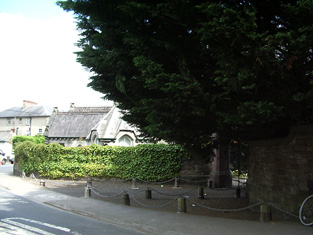
|
| Caher House | A house lived in by the Butler family when they ceased to use Caher Castle as a residence. Wilson mentions the seat of Lord Caher in the town. Located in the town square of Caher it now functions as a hotel. Leet records Lord Cahir as resident at Cahir Castle in 1814 but by 1837 Lewis writes that Cahir House was the seat of the Earl of Glengall. He held this house in fee at the time of Griffith's Valuation when it was valued at £100. |

|
| Mill View | This house was the home of the Sargent family in the 19th century, inhabited by Henry Sargent in 1814 and at the time of Griffith's Valuation. It was held from the Earl of Glengall and valued at £30 in the early 1850s. This house is no longer extant. | |
| Garnavilla | A branch of the Nagle family lived at Garnavilla in the 18th century. They held it on a lease from Lord Caher. James Archer Butler was the occupant of this house in 1837 and in the early 1850s when the house was valued at £21 and held from the Earl of Glengall. A building is still extant at this location. | |
| Ballybrada | The residence of Joseph William Fennell in 1814 and 1837. In 1840 the Ordnance Survey Name Books describe "Ballybrado House" as "old and plain, the residence of William Pnnyfeather". Thomas Fennell held the house and offices and 206 acres including a Quakers' graveyard from William Pennefather at the time of Griffith's Valuation. The buildings were valued at £21. The original house as marked on the first Ordnance Survey map is not extant now. The National Inventory of Architectural Heritage website features Ballybrada House built 1879, possibly by the Denny family. Charles E. Denny was resident in 1906 when the buildings were valued at £141+. |
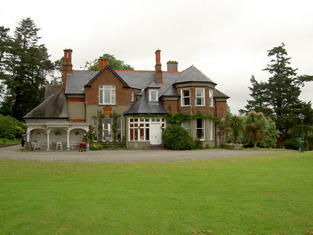
|
| Cottage (Caher) | The residence of George Fennell from 1814 until at least the mid 19th century, when it was valued at £22+ and held from Mrs Rachel Haughton. A building is still located at this site. | |
| Caherabbey House | Occupied by John Fennell in 1814 and by Richard Grubb in 1837. Montgomery records that Richard Grubb built a house at Cahirabbey circa 1833. Richard Grubb held the property in fee at the time of Griffith's Valuation when the buildings were valued at £70. He also had a flour mill closeby valued at £200. In 1894 Slater notes it as the seat of Rev. George Grubb. This house continues to be a family home. In 2013 it was offered for sale. |
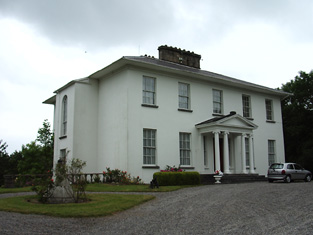
|
| Caherabbey House Upper | Joshua Fennell occupied a house known as Caher-abbey-villa in 1814 and in the early 1850s Joshua Fennell (Joseph) was occupying a house in Caherabbey Upper, valued at £29 and held from Ponsonby Barker. | |
| Alta Villa | The home of a branch of the Going family for much of the 19th century. Charles Going was resident in 1814, William Going in 1837. The Ordnance Survey Name Books describe it as "of modern structure in good repair" in 1840. William Going was also the occupier at the time of Griffith's Valuation when the house was valued at £22+ and his flour mill at £66. The property was held from the representatives of Dunbar Barton. Alexander Going of Alta Villa owned 313 acres in county Tipperary in the 1870s. Sir T. Warren lived at Alta Villa, Cahir in the mid 20th century. Alta Villa is still extant and occupied. |
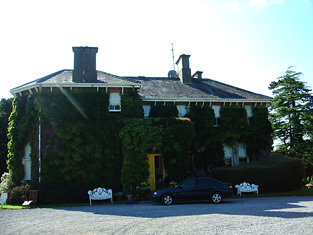
|
| Rochestown | Rochestown came into the possession of the Barton family through the marriage in 1798 of Dunbar Barton and Elizabeth Riall. In 1837 Lewis describes Rochestown as the seat [of their son] S. Barton. Samuel Barton was resident in the early 1850s holding the house valued at £37 from a member of the Beamish family. The National Inventory of Architectural Heritage records the remodelling of the house in 1867 by the Wise family, the design by Sir Thomas Newman Deane. The house was valued at £55 in 1906 and occupied by Francis H. Wise. Damaged by fire in 1918 and completely destroyed by fire in February 1923. |

|
| Swiss Cottage | A thatched house built in a wooded area early in the 19th century and "probably designed by John Nash" (Bence Jones p.53). In the mid 19th century it was valued at £9 and held by the Earl of Glengall in fee. A lithograph of this building is included in the Glengall sale rental of November 1853 and the Burmester, Law and Sadlier sale rental of November 1857. Now in use as a heritage centre. |
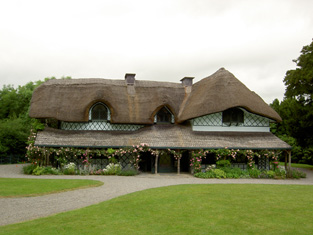
|
| Killemly Lodge | In 1837 the proprietor of Killemly Hall was H. Hughes but it was occupied by L. Clutterbuck. The Ordnance Survey Name Books also note it as his residence in 1840. The house was vacant in the early 1850s, valued at £9.15 shillings and held by Thomas Going from Mrs Catherine Sarsfield. There was a small corn mill nearby. A house is still extant at this location. | |
| Castlegrace | This property has been the home of the Grubb family since the mid 19th century. Griffith's Valuation indicates that it was then held from the Earl of Glengall and the house, offices and flour mill were valued at £122. The National Inventory of Architectural Heritage dates the present house circa 1860 although a lithograph of a very similar building is included in the Glengall sale rental of November 1853 for Castlegrace. Lewis records in 1837 that an extensive flour mill had recently been built by Samuel Grubb of Clogheen. The buildings at Castlegrace were valued at £115 in 1906. This house is still a Grubb family home. http://www.vee.ie/page2.html |

|
| Shanbally Castle | Bence Jones writes that this was the largest of John Nash's Irish castles, built circa 1812 for Cornelius O'Callaghan 1st Viscount Lismore. It was valued at £151 in the mid 19th century. Inherited by two daughters of the Marquess of Ormonde Lady Beatrice Pole Carew and Lady Constance Butler following the death of their cousin the 2nd and last Viscount Lismore in 1898. The Irish Tourist Association Survey in the early 1940s records that the building was taken over by the military authorities "for the duration of the present emergency". Sold by Major Patrick Pole Carew in 1954 and demolished in 1957. |

|
| Shanbally | In 1786 Wilson refers to Shanbally as a seat of Viscount Lismore. It was occupied by John Mahoney and valued at £10.15 shillings at the time of Griffith's Valuation, held from Viscount Lismore. In 1894 Slater refers to it as a residence of Viscount Lismore. | |
| Ballyboy | The residence of John Travers in 1814, of R. Croker in 1837 and vacant in the early 1850s when it was held by James Fennessy from Viscount Lismore. A house and farm are still extant at the site. | |
| Rehill | Rehill was occupied by William Fennell in 1814 and 1837 but by the time of Griffith's Valuation James Mulcahy was resident, holding the property from the Earl of Glengall. The buildings which included a house, offices and corn mill were valued at £62. Sold in 1853 to Robert Murdock and leased by him to Edward Mulcahy. A building is still located as this site. | |
| Carrigataha | The home of W.J. Fennel in 1837 and in 1840. The Ordnance Survey Name Books describe it as "very pleasantly situated and in good repair". It was occupied by Thomas Fennell in the early 1850s. Thomas held the property from a member of the McCarthy family and the buildings were valued at £15. Buildings are still located at this site. | |
| Garryroan House | Robert Fennell occupied this house in 1814 and Joseph R. Fennell at the time of Griffith's Valuation, when the buildings were valued at £14 and held from Lord Waterpark. This was still a Fennell home in the 1870s and continues to be a family residence. In 2012 it was offered for sale. |

|
| Scart | The residence of Robert Croker in 1814 and of Henry Rice in 1837. The Ordnance Survey Name Books refer to it as his residence in 1840, "pleasantly situated on rising ground and in good repair". In the early 1850s Rice held the property from John Bagwell and the buildings were valued at £12+. Henry Rice may have been a son-in-law of Robert Croker. see http://members.iinet.net.au/~nickred/croker_research/The_Irish_CROKER.pdf A building is still located at this site. | |
| Millgrove House | Thomas Jackson occupied this house in 1814 and William Walpole in the 1850s. Walpole held the property from Lord Waterpark and the house, office and corn mill were valued at £38. This house has recently been renovated. |
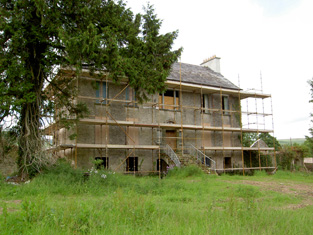
|
| Tincurry House | Abraham Jackson was residing at Tincurry in 1814. The Ordnance Survey Name Books refer to Tincurry as the residence of Stephen Moore in 1840. The building appears to have been in use as a workhouse at the time of Griffith's Valuation. In 1906 Wiliam Jackson Pigott was resident at Tincurry in a house valued at £23+. The National Inventory of Architectural Heritage states that the present house was built in 1932 on the same site as the original house which was blown up by British Forces in 1921. |

|
| Ballydrehid | In 1786 Wilson refers to Ballydrehid as a seat of Viscount Lismore, "pleasantly situated on rising ground". The home of Robert Keating in 1814 and of Robert Doherty in the early 1850s. Doherty held the property from Viscount Lismore and the house was valued at £17. This house is still extant and occupied. |

|
| Kilmoyler | A late 18th century house, the seat of the O'Meagher family, occupied by Dennis O'Meagher in 1814 and 1837 and by Stephen O'Meagher at the time of Griffith's Valuatiton. He held the property in fee and the buildings were valued at £40. In 1865 this property was advertised for sale by the Prestons. The rental records that the house was held on a lease dated 1860 from William O'Meagher to Standish Butler who was resident at the time. In 1786 Wilson had recorded "the castle and house at Kilmoyler, the ancient seat of Colonel Butler". Still extant and occupied. |

|
| Toureen | The first edition Ordnance Survey map marks Toureen House, later maps show a house located a short distance to the south west. Leet and Lewis records Denis O'Meagher as resident at Toureen. This may be the dairy house and offices recorded in Griffith's Valuation and valued at £3.5 shillings held by Stephen O'Meagher in fee. The 25-inch map of the 1890s indicates Tooreen House and a house and substantial farm are still extant at this site. | |
| Toureen Wood House | This house located on the northern fringe of Toureen wood was the home of Philip Maguire in the second half of the 19th century. The site of this house is located near a building marked on the first edition Ordnance Survey map as Maguire's Castle. The sale rental of 1875 refers to a new and comfortable dwelling house on the lands of Toureen, containing 2 good reception rooms, 7 bedrooms. a large kitchen and store room, dairy and pantries. The house was in the owner's possession. A house in the townland of Toureen valued at £7.5 shillings was held in fee by Philip Maguire in the mid 19th century. Lewis records a house known as Kilmoylermore, the residence of "the late Constantine Maguire, Esq." | |
| Ashgrove | In 1786 Wilson refers to Ashgrove as the seat of Mr. Ash. At the time of Griffith's Valuation Ashgrove House was valued at £14.10 shillings and occupied by John Henry Ashe who held it from his brother Trevor Lloyd Ashe. A lithograph of Ashgrove is included in the Ashe sale rental of 1854. It was bought by Charles Moore of Mooresfort. Ashgrove was offered for sale again in 1864. It was held on a lease dated 1815 from Trevor Lloyd Ashe to Southwell Moore for 3 lives renewable for ever. Lyons writes that Southwell Mulcahy was resident from 1858. This house is still in use as a residence. |

|
| Castle Mary | Lewis describes Ashgrove Castle or Castle Mary, the residence of the Reverend Trevor Lloyd Ashe, Lord of the Manor of Bansha, as a "castellated mansion in the Italian style of architecture, situated at the base of the Galtee mountains, 4,000 acres of which are attached to the estate". This house is marked on the first edition Ordnance Survey map. In 1840 the Ordnance Survey Name Books refer to it as the property of T.L. Ashe "of modern construction but in very bad repair". It is recorded as "in ruins" in the later 25 inch map of the 1890s. Land clearance has taken place in the area and nothing remains of Castle Mary. | |
| Ballydavid | G. Baker was resident at Ballydavid in 1837 and in the early 1850s when the house was valued at £13.10 shillings and held from the Reverend George Cole Baker. In 1786 Wilson refers to Ballydavid as the seat of Mr. Baker. In 1840 the Ordnance Survey Name Books had noted that the house was in bad repair though the demesne was described as "neatly ornamented". This house no longer exists. | |
| Clashleigh | Lewis records Claishleigh as the residence of S. Grubb and in Griffith's Valuation Samuel Grubb held a house, office and flour mill valued at £170 in Clogheen Market from Viscount Lismore. His son Henry Samuel Grubb lived at Claishleigh in the 1870s. This house was in use as a rectory in the 20th century. |

|
| Coolville | An early 19th century house, occupied by Richard Grubb in the first half of that century. It was held from Viscount Lismore and with offices and flour mills was valued at £169 in the early 1850s. Home of Edward Sackville West 5th Lord Sackville in the mid 20th century, who added a Gothic conservatory to the building. |

|
| Mountain Lodge | In the mid 19th century Viscount Lismore owned a house/hunting lodge valued at £7 in the townland of Cullenagh (2,740 acres) which he also owned. This building has since been extended and is still in use as a youth hostel. |

|
| Cappagh (Clanwilliam) | In 1786 Wilson refers to Cappagh as the seat of Mr. Massey. At the time of Griffith's Valuation, this townland was the property of estate of Reverend John Massey Dawson. [Grid Reference is approximate]. | |
| Ballymorris | In 1786 Wilson refers to Ballymorris as the seat of Mr. Magher. By the time of Griffith's Valuation the townland was held by Stephen O'Meagher and the buildings were valued at £1. The house appears to be gone by the time the first Ordnance Survey map was published as it is not shown there. | |
| Rosemount (Caher) | In 1840 the Ordnance Survey Name Books refer to Rosemount as a house in good repair, the residence of Robert Franklin. He is also listed as the occupier at the time of Griffith's Valuation, leasing from the Barton estate when the buildings had a valuation of £10. Robert Franklin of Rosemount is listed in Slater's Directory of 1846. The house is no longer extant. | |
| Lissava House | In 1840 the Ordnance Survey Name Books refer to Lissava House as the residence of John Egan. He was recorded among the gentry of Caher in Slater's Directory 1846. He also the occupier in the early 1850s when he was leasing it from the Earl of Glengall's estate. The buildings were valued at £12. A house is still extant at the site. |

